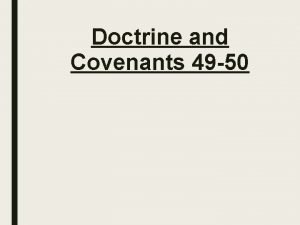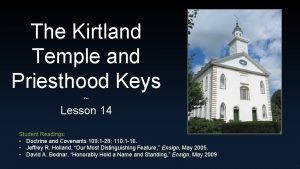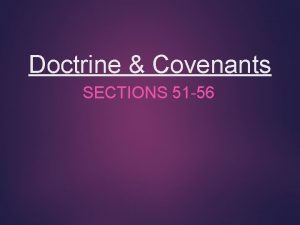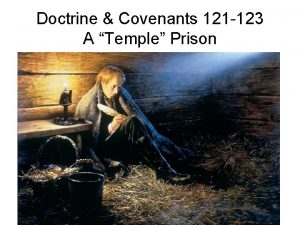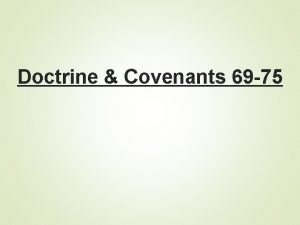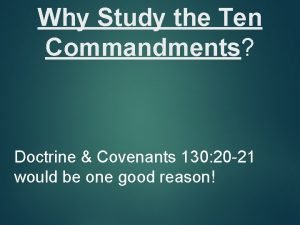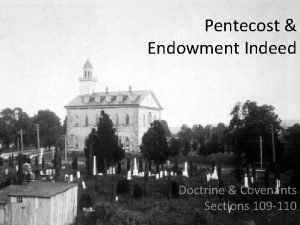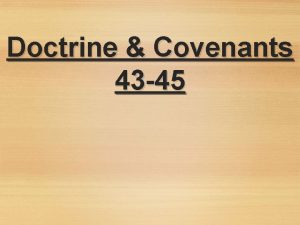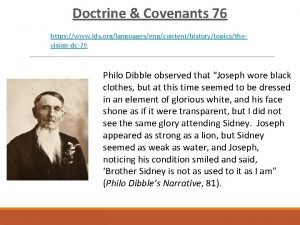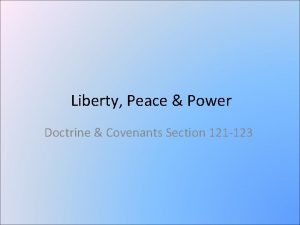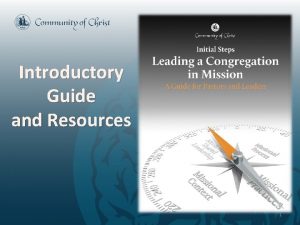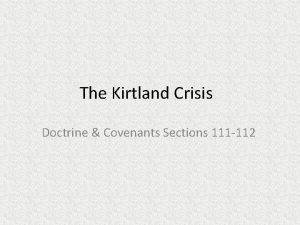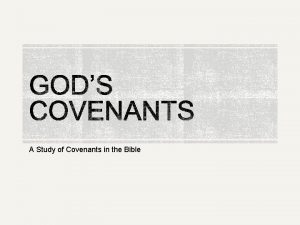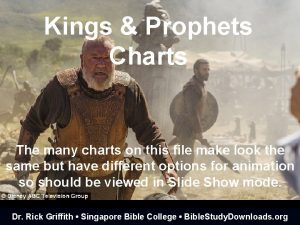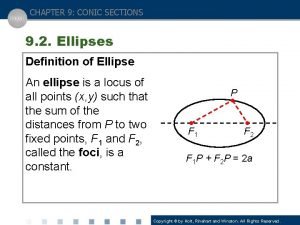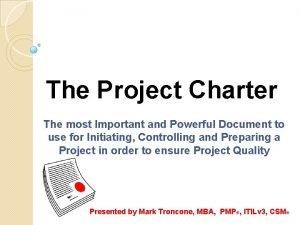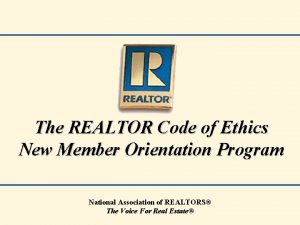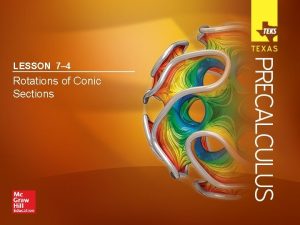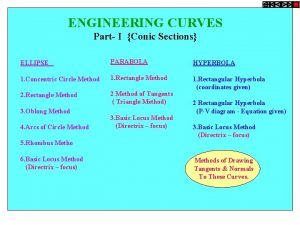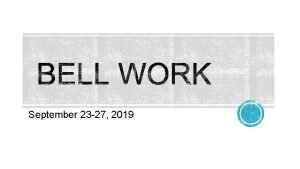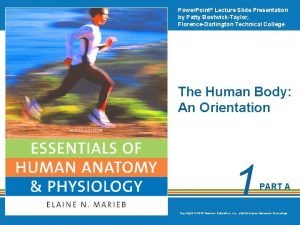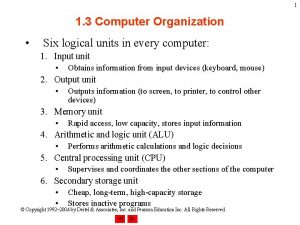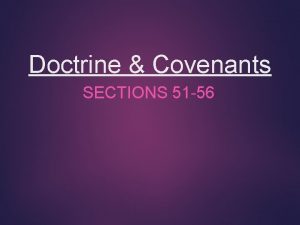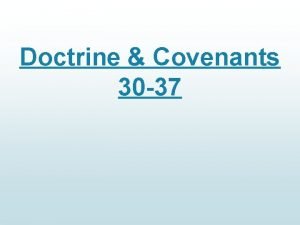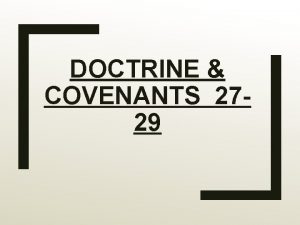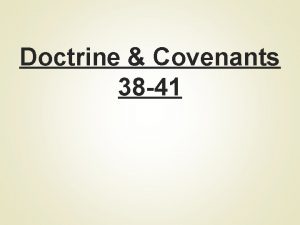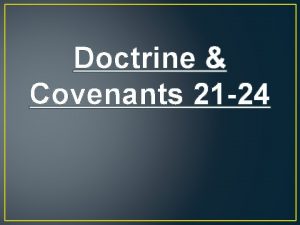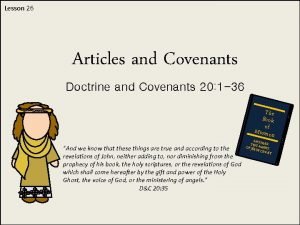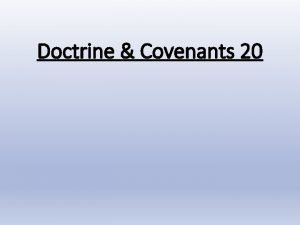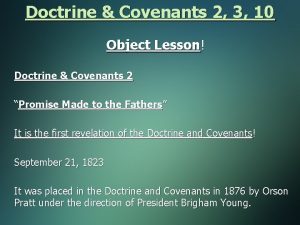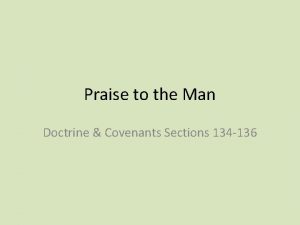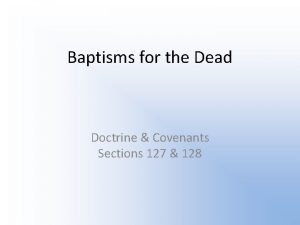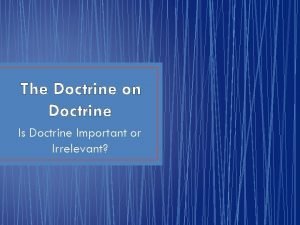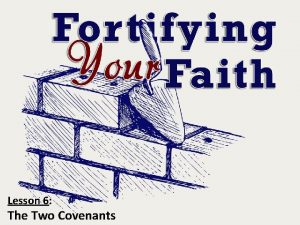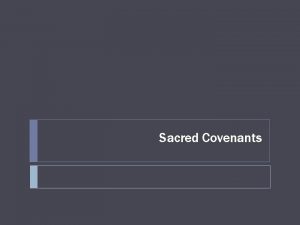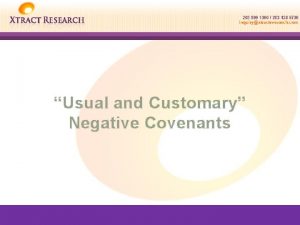Doctrine Covenants SECTIONS 51 56 Doctrine Covenants 51
































- Slides: 32

Doctrine & Covenants SECTIONS 51 -56

Doctrine & Covenants 51 -56 Law of Consecration: 1. Celestial Law 2. Provides economic prosperity among all men! 3. The curse of idleness is to be abolished. 4. The key to make it work? Doctrine & Covenants 51: 9 = (honesty!)

How the Law of Consecration was to work: 1. 2. 3. 4. 5. 6. 7. The earth is the Lords. Men can become stewards of the Lord’s property. You give all you have to the Bishop as the Lord’s representative on earth. You are given back what you need. You then operate that which you have been given. At the end of the year all surplus is given to the Bishop’s storehouse for use of building schools, public roads, etc. At the year’s end a re-evaluation is again made.

President J. Reuben Clark, Jr. , explained: “The fundamental principle of this system was the private ownership of property. Each man owned his portion, or inheritance, or stewardship, with an absolute title, which he could… treat as his own. The Church did not own all of the property” (Conference Report, Oct. 1942, 57).

Definition of Consecration: To make or declare something sacred and to set it aside for God’s purpose! Doctrine & Covenants 51: 3 “Equal? ” This is not a case of dead level equality, it will vary as much as the man’s circumstances. His wants and needs may vary (Conference Report, Oct. , 1942, J. Reuben Clark).

Doctrine & Covenants 51: 3 The Prophet explained in a letter to Bishop Partridge: “To condescend to particulars, I will tell you that every man must be his own judge how much he should receive and how much he should suffer to remain in the hands of the Bishop. I speak of those who consecrate more than they need for the support of themselves and their families.

“The matter of consecration must be done by the mutual consent of both parties; for to give the Bishop power to say how much every man shall have, and he obliged to comply with the Bishop’s judgment, is giving the Bishop more power than a king has; and upon the other hand, to let every man say how much he needs, and the Bishop be obliged to comply with his judgment is to throw Zion into confusion, and make a slave of the Bishop. The fact is, there must be a balance or equilibrium of power, between the Bishop and the people, and thus harmony and good will may be preserved among you.

For now, consecration may not require giving up worldly possessions so much as being less possessed by them. Consecration is… both a principle and a process, and it is not tied to a single moment. Instead, it is freely given, drop by drop, until the cup of consecration brims and finally runs over (Neal A. Maxwell, Ensign, November 1995, 24).

In case the two parties cannot come to a mutual agreement, the Bishop is to have nothing to do about receiving such consecrations; and the case must be laid before a council of twelve High Priests, the Bishop not being one of the counsel, but he is to lay the case before them” (Joseph Smith, History of the Church, 1: 364 -65).

At first, the member leased the land material goods as an individual stewardship, recognizing that the Church retained ownership of the property. Therefore, should an individual leave the Church, the Church held right to the leased land loaned property. Bishop Partridge held title to the land for the Church, but members received the leased land loaned property.

It was determined, however, that this practice did not accord with the law because individuals could not be deprived of property by a religious organization.

Doctrine & Covenants 51: 17 “Let them act upon this land for years” People who locate in a home or apartment knowing that they will move to another in a short time may have a tendency to neglect Church attendance and responsibilities.

Doctrine & Covenants 51: 19 “A faithful, a wise, and a just steward shall enter into the joy of his Lord, and shall have eternal life. ” Doctrine & Covenants 52: 4 The Lord will lead you on your mission if you’re faithful! Doctrine & Covenants 52: 9 -10 “Teach the scriptures and the prophets!

Elder Bruce R. Mc. Conkie bore the following testimony: “The truth of all things is measured by the scriptures. That which harmonizes with them should be accepted; that which is contrary to their teachings should, however plausible it may seem for the moment, will not endure and should be rejected” (Mormon Doctrine, 765).

Doctrine & Covenants 52: 23 (not faithful) Ezra Booth Doctrine & Covenants 52: 29 (true and faithful) Zebedee Coltrin Doctrine & Covenants 52: 30 (true and faithful) Reynolds Cahoon

Doctrine & Covenants 52: 31 Wheeler Baldwin (not faithful) Doctrine & Covenants 52: 37 (not faithful) Symonds Ryder Heman Basset (not faithful)

Wheeler Baldwin Doctrine & Covenants 52: 31 Born in 1793 in New York and died in 1887 at the age of 94 in Missouri. He was a veteran of the War of 1812 and was baptized at the age of 37. Solomon and Levi Hancock, Wheeler, and others were walking toward the Hancock home. Levi recorded: We walked heavily, some said they felt as if they would be seized by Satan. Others that they felt as though the Devil and his angels were hanging about them… When we had got against the pond which was about fourteen rods across and very deep, I said, “Let us pray. ” So we all kneeled down and prayed around a circle as soon as the last one got through about nine o’clock at night and the moon shown brightly. A sudden bray of a jackass was heard about twenty feet behind us. We looked and could see nothing and nothing in the way. It started toward the pond ascended the high hills on the other side until it grew less and less distinct until it got out of hearing.

“There, ” said Brother Baldwin. “This proves to me that this work is true, for we prayed for assistance; the Devil ran away (Autobiography of Levi Ward Hancock, typescript, 34, Special Collections, Harold B. Lee Library, Brigham Young University, Provo, Utah). Two days following the experience he was called to serve a mission with William Carter but Carter refused the mission call. Baldwin stayed in Kirtland strengthened the local congregations. Church historian John Whitmer noted that Baldwin was instrumental in performing mighty miracles. He healed an old lady who was helpless and confined to her bed for eight years. She was not a member and enjoyed perfect health after the blessing. He denied the faith in 1853 and later became affiliated with the Reorganized Church in 1863.

Symonds Ryder: Ezra Booth’s testimony of the Prophet Joseph Smith so impressed him that he sought an audience with the Prophet in Kirtland. He joined the Church in June of 1831. His ministerial call was signed by Joseph Smith and Sidney Rigdon. According to historian James B. Holm, “both in the letter he received and in the official commission to preach, his name was spelled R-i-d-e-r, instead of R -y-d-e-r… He thought if the ‘Spirit’ through which he had been called to preach could err in the matter of spelling his name, it might have erred in calling him to the ministry as well” (Portage Heritage, Ohio: The Portage County Historical Society, 1957, 171). Another historian claimed that when Joseph Smith “misspelled” Ryder’s first name Simon instead of Symonds, Ryder lost faith in him, feeling that if the Lord really did speak to Smith, he would spell his name “correctly. ”

Whatever his reasons for leaving the Church he united in 1831 with his mentor Ezra Booth in planting the seeds of hatred toward Joseph and Mormonism in Hiram. Sidney Rigdon challenged Symonds to a debate on the Book of Mormon to which he refused. Sidney said that Symonds could blow like a porpoise when there was no person to oppose him. In Mormon historical records both Symonds and Booth are recorded as apostate leaders of the mob that tarred and feathered Sydney and Joseph in 1832. Although sometimes rendered as Simonds, the correct spelling of the name is Symonds. He returned to his Campbellite Church in 1831. He died in 1870 at the age of 77. There is a stained-glass window in the church bearing his name.

Simon Rider (Sorry meant Symonds Ryder)


Heman Basset Doctrine & Covenants 52: 37 Born in Vermont in 1814 and died in Pennsylvania in 1876. He is the youngest man in the D&C mentioned along with Joseph Smith, both at 17 years old (Doctrine & Covenants 2). In 1830 Heman was residing with one hundred individuals, known collectively as the “Family, ” at the Isaac Morley farm in Kirtland. He was baptized in 1830. False spirits were detected among the new converts and “many strange visions were seen. Levi Hancock was one of the first to observe Heman as he taught: “Basset would behave like a baboon. He said he had a revelation he had received in Kirtland from the hand of an angel, he would read it and show pictures of a course of angels declared to be Gods, then would testify of the truth of the work and I believed it all, like a fool. ”

While living at the Morely farm, Heman took Levi Hancock’s watch and walked off like it was his. Levi thought he would bring it back, but he went out and sold it. Heman thought it was okay to do so because it was all in the family. Heman was ordained an elder in the spring of 1831. At the June 3 rd Conference of the Church in 1831 Heman was sternly warned by Joseph to sit still because the devil wanted to sift him. Heman was among the first members of the Church to leave the fellowship of the Saints in Ohio. Little is known of his later life except that he managed a hotel in California before migrating to Pennsylvania where he died in 1876.

Zebedee Coltrin’s tombstone at the Spanish Fork Cemetery. He was born on September 7, 1804 and died on July 2, 1887 His tombstone reads, “A Friend of Joseph Smith. A Patriarch and pioneer. His life was marked by faith and zeal. His mission was to bless and heal. ”

Doctrine & Covenants 53 “Algernon Sidney Gilbert” He was devoted and faithful. He lacked ability or confidence in his ability to preach. He said that he would rather die than go preach. He later died when he contracted cholera from men on Zion’s Camp who he was nursing back to health.

Doctrine & Covenants 55: 4 Little Children to receive instruction! Doctrine & Covenants 56: 14 -17 Reasons why we don’t live the Law of Consecration!

Doctrine & Covenants 55 William Wines Phelps Introduced to the gospel by Parley Parker Pratt. He sat up all night to compare the Book of Mormon to the Bible. The following morning he said that he was going to join the church and that he was convinced that it was true. He was baptized on the 10 th of June, 1831 and ordained an Elder by Joseph Smith.

He was not a member when the revelation was given to him. Excluding Sidney Rigdon, W. W. Phelps was the most publicly well-known convert to the early Church. No one was better educated and more articulate than he was in the early days of the Church” (By That Book, ” 2004).

One of the most famous publications printed on his press was the Book of Commandments. He also printed the first newspaper of the Church. The Evening and Morning Star. Excommunicated in 1838 and 1847. He was among the most bitter enemies of the Prophet. By 1840 he had repented and wrote to Joseph Smith: “I am as the prodigal son, though I never doubted or disbelieve the fullness of the Gospel.

I have been greatly humbled… I have done wrong and I am sorry. The beam is in my own eye. I have not walked along with my friends according to my holy anointing. The Prophet responded, “It is true, that we have suffered much in consequence of your behavior --- the cup of gall, already full enough for mortals to drink, was indeed filled to overflowing when you turned against us… ‘Had it been an enemy, we would have borne it. ’ … ‘Come on dear brother, since that was in the past, for friends at first, are friends again at last. ’”

In 1834 he was appointed to the Nauvoo City Council. He was with the Prophet as he rode to Carthage on 24 June 1844. In civil affairs William was a prominent figure in Utah. He died in 1872 at the age of 80. He was an ordinance worker in the Endowment House.
 Doctrine and covenants section 49
Doctrine and covenants section 49 Doctrine and covenants 110:1-10
Doctrine and covenants 110:1-10 Doctrine and covenants
Doctrine and covenants Doctrine and covenants 121-123
Doctrine and covenants 121-123 Doctrine and covenants 69
Doctrine and covenants 69 2 most important commandments
2 most important commandments Doctrine and covenants section 110
Doctrine and covenants section 110 Doctrine and covenants
Doctrine and covenants Book of morm
Book of morm Doctrine and covenants 1:30
Doctrine and covenants 1:30 Doctrine and covenants 76
Doctrine and covenants 76 D&c section 121
D&c section 121 Doctrine and covenants 21
Doctrine and covenants 21 Doctrine and covenants 163
Doctrine and covenants 163 Doctrine and covenants learning assessment
Doctrine and covenants learning assessment Doctrine and covenants section 111
Doctrine and covenants section 111 Doctrine and covenants 38
Doctrine and covenants 38 7 covenants of the bible
7 covenants of the bible Kings of israel and judah good and bad chart
Kings of israel and judah good and bad chart Types of conic sections
Types of conic sections Conic sections ellipse definition
Conic sections ellipse definition Cross slice
Cross slice Project charter sections
Project charter sections Method of sections
Method of sections Realtor code of ethics three major sections
Realtor code of ethics three major sections Rotating conic sections
Rotating conic sections How to draw tangent and normal to cycloid
How to draw tangent and normal to cycloid Rewrite the 9 underline sections
Rewrite the 9 underline sections Me-111
Me-111 Body planes and sections
Body planes and sections Circular graph divided into sectors
Circular graph divided into sectors What are the six logical units of a computer
What are the six logical units of a computer The eiffel tower is divided into three sections
The eiffel tower is divided into three sections
